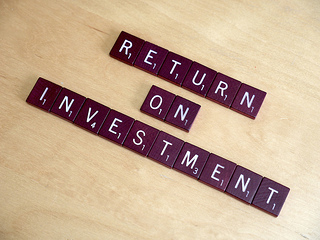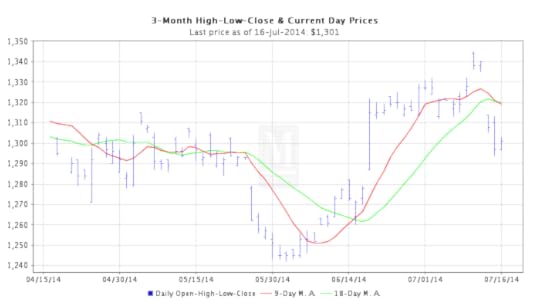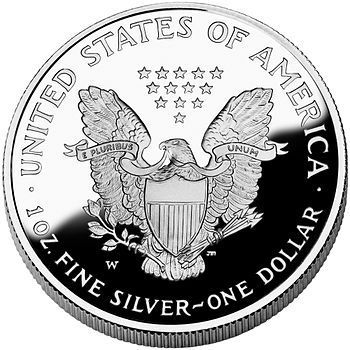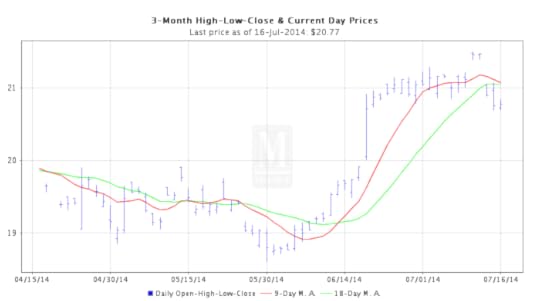Nick Reichert's Blog, page 28
August 29, 2014
Building a Financial Fortress: Getting Started in Real Estate Investing.
I'm very excited to announce the publication of my new book (now available on Amazon.com in print and Kindle versions): Building a Financial Fortress: Getting Started in Real Estate Investing.
In this book, I will walk you through the process of identifying, purchasing, owning and selling investment real property and many of my “lessons learned” along the way. I will also explain the system that I used to achieve my investment objectives.
After reading this book, you should be able to move forward confidently with your own program to invest in real estate and grow your wealth and cash flow!

Related articles Financial Fortress - Hard Assets
Financial Fortress - Hard Assets
 How To Build A Financial Fortress
How To Build A Financial Fortress
In this book, I will walk you through the process of identifying, purchasing, owning and selling investment real property and many of my “lessons learned” along the way. I will also explain the system that I used to achieve my investment objectives.
After reading this book, you should be able to move forward confidently with your own program to invest in real estate and grow your wealth and cash flow!

Related articles
 Financial Fortress - Hard Assets
Financial Fortress - Hard Assets
 How To Build A Financial Fortress
How To Build A Financial Fortress
Published on August 29, 2014 20:22
Publishing my new book on getting started in real estate investing soon!
Published on August 29, 2014 20:22
August 21, 2014
Gold and Silver Opportunity?
Just picked up some more Silver American Eagle and Gold American Buffalo coins today. US Dollar has strengthened lately on assumption by investors that Fed will raise interest rates soon due to apparent strength in US economy. Unemployment continues to be stubbornly high for a recovery, however, which will bias the Fed's outlook. The stronger dollar has weakened precious metals. Strength recently in US stock market has also trumped safe haven investments. At the same time, nothing has fundamentally changed in Fed policy of easy money and continued long term devaluation of the dollar. This is really the only way to deal with the growing US national debt. Current gold and silver weakness could be a buying opportunity.

Published on August 21, 2014 14:57
August 9, 2014
Introduction to My New Book - Building a Financial Fortress: Getting Started in Real Estate Investing
I just finished writing the introduction to my next book:
“It takes money to make money.” How many times have you heard that? While it’s true that many investment opportunities require a significant amount of up-front cash (and real estate is certainly one of them), why let that stop you? There are other rationalizations for not wanting to invest in real estate:
• I don’t want to be a landlord
• I don’t want to fix light bulbs and toilets
• It’s too risky
• It’s too complicated
I had many of these same thoughts about 10 years ago, when I bought my first investment property. Because I knew that investing in real estate is the best way to build wealth over time, I had to overcome each one through self-motivation, self-education and developing a real estate investing strategy that met a few important requirements:
• Minimize up-front cash investment required, because I didn’t have much to start with
• Minimize cost of ownership of the property
• Find a good property in a good location with potential for appreciation
• Achieve positive cash flow
• Reduce risk
The most important requirement for me was to have fun and enjoy the process of becoming a real estate investor. Life is too short to not enjoy what you are doing, especially if it will require some effort on your part.
In this book, I will walk you through the process of identifying, purchasing, owning and selling investment real property and my “lessons learned.” I will also explain the system that I used to achieve my investment objectives outlined above.
After reading this book, you should be able to move forward confidently with your own program to invest in real estate and grow your wealth and cash flow!
Nick Reichert
Twitter: @NickReichert
Facebook: BuildingAFinancialFortress
Related articles Building a Financial Fortress: Now Available on Kindle
Building a Financial Fortress: Now Available on Kindle
 Financial Fortress - Hard Assets
Financial Fortress - Hard Assets
 Stay Diversified - Resist Temptation
Stay Diversified - Resist Temptation
 How To Build A Financial Fortress
How To Build A Financial Fortress
"Real estate investing, even on a very small scale, remains a tried and true means of building an individual's cash flow and wealth."
Robert Kiyosaki
“It takes money to make money.” How many times have you heard that? While it’s true that many investment opportunities require a significant amount of up-front cash (and real estate is certainly one of them), why let that stop you? There are other rationalizations for not wanting to invest in real estate:
• I don’t want to be a landlord
• I don’t want to fix light bulbs and toilets
• It’s too risky
• It’s too complicated
I had many of these same thoughts about 10 years ago, when I bought my first investment property. Because I knew that investing in real estate is the best way to build wealth over time, I had to overcome each one through self-motivation, self-education and developing a real estate investing strategy that met a few important requirements:
• Minimize up-front cash investment required, because I didn’t have much to start with
• Minimize cost of ownership of the property
• Find a good property in a good location with potential for appreciation
• Achieve positive cash flow
• Reduce risk
The most important requirement for me was to have fun and enjoy the process of becoming a real estate investor. Life is too short to not enjoy what you are doing, especially if it will require some effort on your part.
In this book, I will walk you through the process of identifying, purchasing, owning and selling investment real property and my “lessons learned.” I will also explain the system that I used to achieve my investment objectives outlined above.
After reading this book, you should be able to move forward confidently with your own program to invest in real estate and grow your wealth and cash flow!
Nick Reichert
Twitter: @NickReichert
Facebook: BuildingAFinancialFortress
Related articles
 Building a Financial Fortress: Now Available on Kindle
Building a Financial Fortress: Now Available on Kindle
 Financial Fortress - Hard Assets
Financial Fortress - Hard Assets
 Stay Diversified - Resist Temptation
Stay Diversified - Resist Temptation
 How To Build A Financial Fortress
How To Build A Financial Fortress
Published on August 09, 2014 19:32
August 1, 2014
More Commentary on Diversification
 English: Phillippine stock market board (Photo credit: Wikipedia)Today I received an email from Fidelity, the custodian of my 401(k) plan. The timing couldn't be better after the last two days of stock market losses.
English: Phillippine stock market board (Photo credit: Wikipedia)Today I received an email from Fidelity, the custodian of my 401(k) plan. The timing couldn't be better after the last two days of stock market losses.This is what it said:
"Based on a review of your workplace savings plan, it appears that your current investment mix may not be appropriate for your age. As your life and the financial markets change, your investment mix needs to keep pace—and we can help you find ways to make that happen."
This is my current 401(k) portfolio allocation:
Short Term - 42%Domestic Stock - 25%Foreign Stock - 23%Bonds 9% Other 1%
With all the market volatility now, I'm pretty happy with this mix. I'm not confident in the bond or stock markets at this time. If anything, growth looks better overseas even if there's greater volatility so I split the stock exposure 50/50. I also chose to be heavily in cash. I'm not making a lot of money, but I haven't lost a lot either in the last few days. Even if the US stock market were to suffer a serious correction and half the value were erased, I would only lose 12.5% of the value of my portfolio. I can live with that. And thanks, Fidelity, my asset allocation is just fine.
For more ideas on protecting and building your wealth, please check out my new book Building a Financial Fortress.
For more on Diversification, please read my previous posts:
Related articles
 What is the True Meaning of "Diversified Investment Portfolio?"
What is the True Meaning of "Diversified Investment Portfolio?"
 Managing Investment Risk Through Diversification
Managing Investment Risk Through Diversification
 Stay Diversified - Resist Temptation
Stay Diversified - Resist Temptation
Published on August 01, 2014 21:06
July 29, 2014
Savings Strategy
 money (Photo credit: 401(K) 2013)I have always found that the easiest way to save money is to do so automatically whenever possible - effectively "hiding" the money from yourself, ideally in an account that is easy to deposit into but is hard to withdraw from. For example, having the money direct deposited into your 401(k) account from your paycheck each pay period or having funds withdrawn from your checking account into your savings account automatically each month. This ensures that you are "paying yourself first" and are removing the temptation to spend the money. Whenever you get an unexpected payment (i.e., a bonus or a raise), its best to try to save as much of that as possible and continue to live on the monthly salary that you received before the raise or bonus. It might be tempting to want to go out and buy a nice vacation or a new car, but being disciplined about saving will ensure you continue to build your savings over the long haul. I have found that saving a small amount each month for my kids' college funds, for example, is relatively painless and over time those amounts really build up. We set aside a set amount each month for each of our kids automatically and when the cash builds up to a certain level, the funds are invested. All our kids have Uniform Transfer to Minors Accounts (UTMA) now. I tried two different 529 plans over the years and each one had horrible investment returns. I think having the flexibility in how to invest and ultimately spend the funds outweighs the tax benefits and limitations (i.e., only can be used for higher education) of the 539 Plan.
money (Photo credit: 401(K) 2013)I have always found that the easiest way to save money is to do so automatically whenever possible - effectively "hiding" the money from yourself, ideally in an account that is easy to deposit into but is hard to withdraw from. For example, having the money direct deposited into your 401(k) account from your paycheck each pay period or having funds withdrawn from your checking account into your savings account automatically each month. This ensures that you are "paying yourself first" and are removing the temptation to spend the money. Whenever you get an unexpected payment (i.e., a bonus or a raise), its best to try to save as much of that as possible and continue to live on the monthly salary that you received before the raise or bonus. It might be tempting to want to go out and buy a nice vacation or a new car, but being disciplined about saving will ensure you continue to build your savings over the long haul. I have found that saving a small amount each month for my kids' college funds, for example, is relatively painless and over time those amounts really build up. We set aside a set amount each month for each of our kids automatically and when the cash builds up to a certain level, the funds are invested. All our kids have Uniform Transfer to Minors Accounts (UTMA) now. I tried two different 529 plans over the years and each one had horrible investment returns. I think having the flexibility in how to invest and ultimately spend the funds outweighs the tax benefits and limitations (i.e., only can be used for higher education) of the 539 Plan. Related articles
 Tax traps abound for college savings accounts
Tax traps abound for college savings accounts
 When Your Budget Doesn't Cut It: Early Withdrawals from Retirement Savings Plans
When Your Budget Doesn't Cut It: Early Withdrawals from Retirement Savings Plans
 Need Money? Personal Finance Tips When Borrowing from a Retirement Account
Need Money? Personal Finance Tips When Borrowing from a Retirement Account
 Improve your financial life - automatically
Improve your financial life - automatically
Published on July 29, 2014 23:26
July 26, 2014
Managing Investment Risk Through Diversification
 Return on Investment (Photo credit: LendingMemo)I was just talking to someone earlier today about investing. He felt like there was really nothing that was a "good deal" right now and seemed content to sit in cash. A quick survey of the investment landscape would indicate that there is quite a bit of risk in investing in many asset classes, including stocks, bonds, real estate, precious metals, etc. However, even cash poses a risk due to inflation eroding the value of money. In particular, there are many observers of the stock market who are saying it has "topped out" or it's going to crash. The same can be said for other asset classes as well - bonds are too risky if interest rates rise/inflation comes and real estate values have increased dramatically since the Great Recession are other examples. The truth of the matter is a good investor can make money in any market environment through diversification.
Return on Investment (Photo credit: LendingMemo)I was just talking to someone earlier today about investing. He felt like there was really nothing that was a "good deal" right now and seemed content to sit in cash. A quick survey of the investment landscape would indicate that there is quite a bit of risk in investing in many asset classes, including stocks, bonds, real estate, precious metals, etc. However, even cash poses a risk due to inflation eroding the value of money. In particular, there are many observers of the stock market who are saying it has "topped out" or it's going to crash. The same can be said for other asset classes as well - bonds are too risky if interest rates rise/inflation comes and real estate values have increased dramatically since the Great Recession are other examples. The truth of the matter is a good investor can make money in any market environment through diversification.As investors, we need to look at the array of assets that can be invested in and make sure we are broadly invested in a number of different asset classes. Wealthy investors stay diversified and also stay liquid to take advantage of new investment opportunities.
For example:
Stocks (including options) - 20%Bonds - 20%Cash - 20%Real Estate - 20%Alternatives (early stage companies, oil & gas partnerships, precious metals, etc.) - 20%By following a broad diversification strategy, you don't have to worry about timing the market and potentially losing a significant portion of your net worth in a market downturn.
When making individual investments, risk management should also be a priority. The first order of business in risk management is in doing your homework. Don't rely completely on others. Make sure you thoroughly research new investments and consult with those you trust for their opinion. Also, make sure you have a plan for when you want to exit the investment (i.e., sell after 30% return, 100% return, or if it drops by more than 20%). Investing should be taking calculated risks, not gambling. If you are buying a new stock, review the company's financial statements - are they showing strong and steady growth in cash flow? If they pay a dividend, have they consistently increased it and does it look like they can sustain it? Does the company have a good management team?
Sometimes you know more than you think - for example, someone I know shops a lot at Costco and knows the product offering there very well. In late 2009, she wanted to buy some shares but instead her stock broker convinced her to buy Lowe's instead. Guess which stock did better during that timeframe?
Lowe's vs Costco Chart
Related articles
 Stay Diversified - Resist Temptation
Stay Diversified - Resist Temptation
 Asset Class Review: Precious Metals Are Looking Attractive Again
Asset Class Review: Precious Metals Are Looking Attractive Again
 What is the True Meaning of "Diversified Investment Portfolio?"
What is the True Meaning of "Diversified Investment Portfolio?"
 Asset Allocation - How 'Spreading the Love' Will Save Your Portfolio
Asset Allocation - How 'Spreading the Love' Will Save Your Portfolio
Published on July 26, 2014 15:20
July 17, 2014
Risk Off
After a sell off a few days ago, gold had a nice move up today in reaction to world events and "risk off" reaction. Treasuries also rallied, with shorter durations benefiting the most.
The only certainty is that market volatility will continue and could worsen in the near term.
Investors who are broadly diversified and following the Financial Fortress concept shouldn't be concerned about this and will be positioned to profit from any market situation that develops in the coming weeks and months.
3_MONTH07/17/14 7:41pm3 Month Treasury Bill0.03+0.01+25.00%
MJJBONDS ›6 mo Treasury0.060.000.00%2 yr Treasury0.48+0.02+3.48%5 yr Treasury1.66+0.03+2.04%10 yr Treasury2.48+0.03+1.26%30 yr Treasury3.30+0.03+0.86%

Related articles China's Role in U.S. Treasury Yields
China's Role in U.S. Treasury Yields
 Is Now the Time to Seek Inflation Protection?
Is Now the Time to Seek Inflation Protection?
 What is Your Risk Appetite?
What is Your Risk Appetite?
 10 Questions About Gold Investing In 2014
10 Questions About Gold Investing In 2014
The only certainty is that market volatility will continue and could worsen in the near term.
Investors who are broadly diversified and following the Financial Fortress concept shouldn't be concerned about this and will be positioned to profit from any market situation that develops in the coming weeks and months.
3_MONTH07/17/14 7:41pm3 Month Treasury Bill0.03+0.01+25.00%
MJJBONDS ›6 mo Treasury0.060.000.00%2 yr Treasury0.48+0.02+3.48%5 yr Treasury1.66+0.03+2.04%10 yr Treasury2.48+0.03+1.26%30 yr Treasury3.30+0.03+0.86%

Related articles
 China's Role in U.S. Treasury Yields
China's Role in U.S. Treasury Yields
 Is Now the Time to Seek Inflation Protection?
Is Now the Time to Seek Inflation Protection?
 What is Your Risk Appetite?
What is Your Risk Appetite?
 10 Questions About Gold Investing In 2014
10 Questions About Gold Investing In 2014
Published on July 17, 2014 23:51
July 12, 2014
Gold and Silver Making Moves Lately
 American Silver Eagle (Photo credit: Wikipedia)Both gold and silver have moved up strongly since bottoming in late May. Conflict in the Middle East, inflation fears, seasonality and flight to safety helped along with the recognition that there is value at these levels. Easy Central Bank policies worldwide continue to devalue paper currency and seem unlikely to end in the near future because of sluggish economic growth and elevated unemployment.
American Silver Eagle (Photo credit: Wikipedia)Both gold and silver have moved up strongly since bottoming in late May. Conflict in the Middle East, inflation fears, seasonality and flight to safety helped along with the recognition that there is value at these levels. Easy Central Bank policies worldwide continue to devalue paper currency and seem unlikely to end in the near future because of sluggish economic growth and elevated unemployment. For investing in silver, I prefer buying US Silver Eagle coins and holding them physically in a bank safe deposit box that I control. For investing in gold, I also like US Gold Buffalo coins in physical form. EBay is a good place to check current pricing and also to buy physical coins, or you can go direct to dealers and sometimes get a better price. You can also invest in the gold and silver exchange traded funds (GLD and SLV). ETF's allow for easy trading, but no control over the physical asset and operating costs can be high for storage of physical gold that backs the ETF. Another way to play gold and silver is to invest in mining companies, which have outperformed the underlying metal over the past three months. You can invest in specific companies such as Freeport-McMoRan Copper & Gold (FCX) or an ETF such as Market Vectors ETF Trust Market Vectors Gold Miners (GDX).


Related articles
 Mint.com: Gold Fever: The Gold Rush and Gold Standard
Mint.com: Gold Fever: The Gold Rush and Gold Standard
 SILVER - $150/oz Possible In Coming Months Due To Tiny Size Of Physical Market
SILVER - $150/oz Possible In Coming Months Due To Tiny Size Of Physical Market
 The Case For $5,000 Silver - Yes, $5,000 Silver
The Case For $5,000 Silver - Yes, $5,000 Silver
 Silver Up 10.3% YTD - Outperformance To Continue
Silver Up 10.3% YTD - Outperformance To Continue
Published on July 12, 2014 23:52
July 9, 2014
Building a Financial Fortress - Now Available in Paperback on Amazon.com
[image error]
[image error]
Building A Financial Fortress - Lessons from the Great Recession for Savers and Investors

Published on July 09, 2014 21:27



